Quincy Magoo turns 70 this Sunday, September 29, so today we present his debut LP starring Jim Backus, Daws Butler and the composer of many UPA and Jay Ward themes.

MAGOO IN HI-FI and MOTHER MAGOO SUITE
Starring the Voice of Jim Backus
Dennis Farnon and His Orchestra
RCA Victor Records LPM-1362 (12” 33 1/3 RPM / Mono)
Released in 1956. Solo Trumpet/Piccolo: Paul Geil. Writer: Bill Olofson. Running Time: 38 minutes.
Performers: Jim Backus (Mister Magoo); Daws Butler (Waldo); Marni Nixon (Soprano Soloist); Paul Geil (Piccolo Trumpet Soloist).
Magoo in Hi-Fi Selections: “Magoo Opening,” “Le Jazz Warm,” “Portrait of Mr. Magoo,” “Wormwood Scrubs March,” by Dennis Farnon; “If I Had the Wings of an Angel (The Prisoner’s Song” by Vernon Dalhart.
Mother Magoo Suite Selections: “Half the King’s Men,” “Very Contrary Mary,” “Hip Pocket Full of Rye,” “The Little Miss Muffet It,” “Not-So-Simple Simon,” “Sheepish Bo-Peep,” “The Little Boy Blew” by Dennis Farnon.
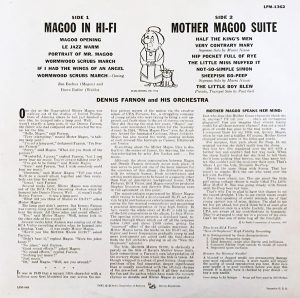 When the short Ragtime Bear premiered on September 29th, 1949, little did UPA know that a cartoon star was born. It wasn’t exactly their plan, as the studio that was going to “break the rules” by avoiding cute animals, regular characters, Disney-style storytelling and other animation traditions. Magoo was a force to be reckoned with and he outlived his studio long after one feature film (please see this Spin), three TV series and a landmark holiday special (also please see this Spin). (There was also a live-action feature, but what did Thumper’s father tell him about saying something nice?)
When the short Ragtime Bear premiered on September 29th, 1949, little did UPA know that a cartoon star was born. It wasn’t exactly their plan, as the studio that was going to “break the rules” by avoiding cute animals, regular characters, Disney-style storytelling and other animation traditions. Magoo was a force to be reckoned with and he outlived his studio long after one feature film (please see this Spin), three TV series and a landmark holiday special (also please see this Spin). (There was also a live-action feature, but what did Thumper’s father tell him about saying something nice?)
He also made a handful of records and this was his first long-player. Before stereophonic records were introduced in late 1957 and were the equivalent of recent home entertainment sensations high-def or 3-D electronics, record labels reached for increasingly better quality in single-channel monophonic sound, or “high-fidelity.” RCA Victor called their breakthrough “Orthophonic” sound.
For Magoo in Hi-Fi, writer Bill Olafson’s used the premise of Magoo playing with his hi-fi (undoubtedly augmented with Backus ad-libs) to spoof high fidelity “test records” of the ‘50s, sold in stores and by record clubs. They “tested” the sound quality of record players but they also touted the labels’ products and superior sound quality. (When stereo came about, “test records” appeared in stacks, beginning with what is believed to be the first one: Audio Fidelity’s Stereophonic Demonstration and Sound Effects Record). Disney got into the act with Disneyland Stereophonic Highlights, which promoted both Sleeping Beauty–Disney’s first full stereo soundtrack album–and Fantasia.)
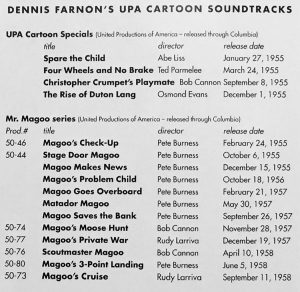 As Magoo, Jim Backus gives a sly wink to RCA when he mentions “the Orthophonic curve” (the curve being the angle of the tonearm) while jabbering delightfully through side one of this album. Daws Butler—one year away from beginning his Hanna-Barbera career with Ruff and Reddy—fills in for Jerry Hausner as Magoo’s nephew Waldo.
As Magoo, Jim Backus gives a sly wink to RCA when he mentions “the Orthophonic curve” (the curve being the angle of the tonearm) while jabbering delightfully through side one of this album. Daws Butler—one year away from beginning his Hanna-Barbera career with Ruff and Reddy—fills in for Jerry Hausner as Magoo’s nephew Waldo.
Though Magoo is renowned for his myopia, he has the ability to read the hi-fi instructions, otherwise the record’s premise would not work (unless Waldo read the manual). However, there was more to the comic aspects of the early Magoo than nearsightedness. In their book Of Mice and Magic, Leonard Maltin and our own Jerry Beck point out that the early Magoos’ comedy also sprang from stubborn unwillingness to admit his errors. His flimsy excuses and cranky, scattershot blaming are traits that make his character more funny and relatable (though more subtle and recognizable to adults).
The Magoo in Hi-Fi album, like the bulk of UPA’s early output, was highly unique, non-traditional and yet often mistaken as children’s material. This LP was usually placed in the “kiddie” section of record stores. The cartoony cover and the Mother Goose selections give the mistaken impression that it will sound like the Peter Pan Players or Anne Lloyd and the Sandpipers.
The presence of the great Marni Nixon, who went on to record a number of Disney records, was in The Sound of Music and Hanna-Barbera’s Jack and the Beanstalk (including the “second cast” album of Mary Poppins) might also suggest children’s fare (at least to those who came to know her in the ‘60s), but here she performs two songs in the Mother Goose Suite that are bizarre rather than peppy. “Very Contrary Mary” is a moody piece, and “Sheepish Bo-Peep” is space-age pop that anticipates Loulie Jean Norman’s similar warbling over the original Star Trek theme.
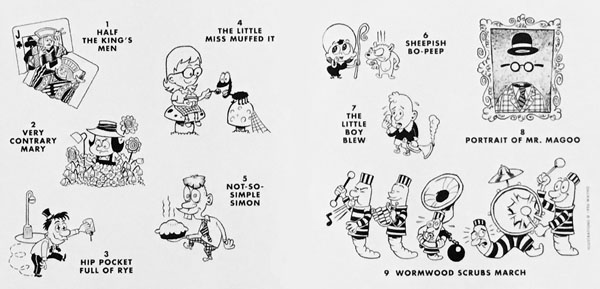
For fans of UPA and Jay Ward animation. the whole thing is pure gold because Dennis Farnon composed a number of themes and instrumentals for both studios. He was also the musical director for Golden Records’ classic Rocky and His Friends album, which was explored in this Animation Spin.
In many of the tracks, it’s possible to hear one UPA or Jay Ward musical similarity after another. With the possible exception of library music albums (several of which Farnon also composed), this is a rare opportunity to enjoy the wonderfully odd, defiantly different musical sounds of modern era animation on one distinctive disc.
“Magoo in Hi-Fi”
The five compositions are joined together into one complete program as if Magoo is playing them on his hi-fi set. Note the changes in tone when he adjusts the bass and treble controls during “Le Jazz Warm,” which also demonstrates the wide frequency range of RCA recordings.
Dennis Farnon’s MOTHER MAGOO SUITE
The Metropole Orchestra Conducted by Jan Stulen
Basta Records 30-9071-2 (Compact Disc / Stereo)
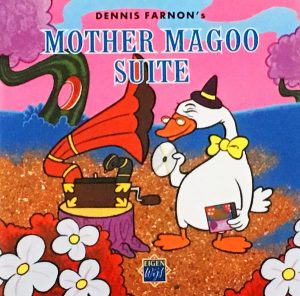
Released in 1996. Producer: Gert-Jan Blom. Soprano Soloist: Fay Lovsky. Piccolo Trumpet Soloist: Jelle Schouten. Chief Sound Engineer: Paul Larnednoye. Assistant Engineers: Frank van Kleef, Ronald ’t Hart. Sound Mixers: Hugh den Orden, Gert-Jan Blom. Art Direction/Liner Notes: Piet Schreuders. Cover Art/Illustrations; Wayno. Special Thanks: Jerry Beck, Bob Strickland, Jerry Weber. Running Time: 29 minutes.
Mother Magoo Suite: “Half the King’s Men,” “Very Contrary Mary,” “Hip Pocket Full of Rye,” “The Little Miss Muffet It,” “Not-So-Simple Simon,” “Sheepish Bo-Peep,” “The Little Boy Blew” by Dennis Farnon.
Bonus Magoo in Hi-Fi Selections: “Portrait of Mr. Magoo,” “Wormwood Scrubs March” by Dennis Farnon.
What a wondrous gift this is for UPA music lovers! Through an interesting set of circumstances, selected Magoo music created by Dennis Farnon was re-recorded in stereo by a Dutch orchestra using the same charts, furnished by composer himself, who sat in on the sessions.
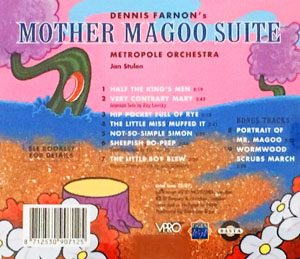 The Magoo in Hi-Fi album had made its way to Amsterdam in the 1960s, where writer/researcher Tom Steen had made it part of his library. A cartoon and comedy enthusiast, Steen passed it along to broadcaster Wim Noordhoek, who incorporated parts of it (and other cartoon records) into various Dutch radio productions. Decades later, Noordhoek gave it to Piet Schreuders—who wrote the excellent liner notes for this CD—and he also shared it with radio producer Gert-Jan Blom for cartoon music radio project they were doing at the time. A few years later, American record producer Irwin Chusid contacted Schreuders with the news that Dennis Farnon was living right there in Holland, and he still had the original arrangments for the Magoo album, making a brand new recording possible.
The Magoo in Hi-Fi album had made its way to Amsterdam in the 1960s, where writer/researcher Tom Steen had made it part of his library. A cartoon and comedy enthusiast, Steen passed it along to broadcaster Wim Noordhoek, who incorporated parts of it (and other cartoon records) into various Dutch radio productions. Decades later, Noordhoek gave it to Piet Schreuders—who wrote the excellent liner notes for this CD—and he also shared it with radio producer Gert-Jan Blom for cartoon music radio project they were doing at the time. A few years later, American record producer Irwin Chusid contacted Schreuders with the news that Dennis Farnon was living right there in Holland, and he still had the original arrangments for the Magoo album, making a brand new recording possible.
Schreuders’ liner notes (compiled with some help from Jerry Beck) are chock full of interesting facts, including a mention that Farnon worked with a singer named Johnny Holiday in Chicago (the same Johnny Holiday who wrote and sang those themes on Sam Singer cartoons like Bucky and Pepito and did the voice of Courageous Cat’s nemesis, The Frog?) and a list of Farnon’s UPA credits (he composed the music for twelve Magoo shorts and four other UPA cartoons).
Farnon was also a West Coast album director at RCA Records in the ‘50s, where in addition to mainstream records, he requested to make the Magoo in Hi-Fi in order to get some of the UPA-style music on record. His “Mother Magoo Suite” was inspired by Ravel, one of his favorite composers. When asked by Schreuders if there was a conscious movement among composers of his day, like Esquivel, Roger Roger or Andre Popp to twist Ravel, Stravinsky or Respighi into quirky, three-minute instrumentals, he said, “I never thought of that; I never thought, I should do this—I just did it.
“I think I just liked funny music. The stuff I did that UPA heard, was of that type, and that was about 1954. It’s like scientists working on something on one country and in another country—they don’t know about each other’s research, but they’re all on the same track. I didn’t know the work of those other arrangers. I didn’t even have a record player, because I hadn’t been out to California long…”
“Dennis Farnon’s Mother Goose Suite”
In addition to re-creating the entire Suite note-for-note in glorious stereo, there are also two tracks from the Magoo in Hi-Fi side of the RCA album included.


 GREG EHRBAR is a freelance writer/producer for television, advertising, books, theme parks and stage. Greg has worked on content for such studios as Disney, Warner and Universal, with some of Hollywood’s biggest stars. His numerous books include Mouse Tracks: The Story of Walt Disney Records (with Tim Hollis). Visit
GREG EHRBAR is a freelance writer/producer for television, advertising, books, theme parks and stage. Greg has worked on content for such studios as Disney, Warner and Universal, with some of Hollywood’s biggest stars. His numerous books include Mouse Tracks: The Story of Walt Disney Records (with Tim Hollis). Visit 





















































Mr. Magoo was a hugely popular cartoon character in his day. Probably one important aspect of his popularity was due to his being a human instead of an animal. And yes, it’s true that there was more to his personality than the near-sightedness. It’s unfortunate that he became a one-joke character when so much more could have been done with him. Jim Backus really brought the character to life in all of the many incarnations of Magoo.
Contrary to popular misconception, Magoo is not blind. He has distorted vision due to his being near-sighted, the same type of condition that I have, and yes, it is possible to mistake one thing for something else entirely if I am not wearing my glasses. Magoo’s condition is compounded by his tendency to be a bit delusional. He creates his own reality, which more often than not conforms to his expectations, at least in his own mind. Paired with his natural stubbornness, and his denial of the fact that he needs glasses, his re-interpretation of the world around him leads to comical results. But it is a total mistake to assume that the Magoo cartoons are making fun of blind people, because Magoo is sighted.
There are many other aspects to his character. He is generous, kind-hearted, benevolent, though he can be crotchety and cantankerous as well. He is a patron of the arts and a part-time actor, as witnessed in several of the shorts and the entire TV series “The Famous Adventures of Mr. Magoo”. He is a devoted uncle to his nephew Waldo, and his later nephew Justin, as well as being fond of his many pets, including Bowzir, Hamlet, Caesar, and McBarker. It’s too bad these aspects never got as much play as his near-sighted delusions.
Thanks for this chance to re-live some fond memories of Mr. Magoo.
Excellent points all. I liked the fact that Mr. Magoo often enjoyed things very much when he wasn’t being fussy. He would cackle with delight at the simplest pleasures of life, which apparently was a lovable trait of Jack Benny. It might be one reason that Magoo was employed as a commercial pitchmen. (“Ah! La-Z-Boy! World’s finest chair.”_
Ah, you’ve done it again! Thanks for another wonderfully informative post. Though a long-time devotee of cartoon music, I must confess that Dennis Farnon’s name was unfamiliar to me before today. Goldmark’s “Tunes for ‘Toons” mentions him only in passing; Goldmark and Taylor’s “The Cartoon Music Book”, not at all.
The “Mother Magoo Suite” actually bears very little resemblance to Ravel’s “Ma Mere l’Oye”, a set of piano pieces for children that the composer later orchestrated. (The orchestral version is surprisingly difficult.) With its marches fading in and out, intentional wrong notes, and bi- and polytonality, it sounds more like something out of Charles Ives. Goldmark described Farnon as a “progressive” composer, but Ives was about as out there as you can get! The music of “Magoo in Hi-Fi” sounds very much like Prokofiev, especially his first symphony (the “Classical Symphony”) and the Lieutenant Kije Suite.
I’m less familiar with UPA cartoons than I am with Jay Ward, where the music occurs mainly over the titles and interstitials; there’s very little music in the cartoons themselves (the only instance I can think of offhand is the a capella singing contest in which Bullwinkle and Boris vie for the adulation of the Moon Mice). It’s nice that, with these two albums, Dennis Farnon had a chance to spread his wings and show cartoon fans what he was really capable of creating.
Dennis Farnon is also the uncle of Shannon Farnon, voice of Wonder Woman on Hanna-Berbera’s Super Friends, Charmian Carr, who played Liesl in The Sound of Music, and Darleen Carr, who voiced The Girl in The Jungle Book and played Karl Malden’s daughter on The Streets of San Francisco.
Anyone else notice how Miss Muffet on the sleeve looks an awful lot like Sherman in drag?
Actually, the “Orthophonic Curve” has little to do with the shape of the tonearm. It is the process of amplifying and attenuating high and low frequencies during recording, then reversing them during playback. The terms “turnover” and “rolloff” are used to define the curve. For the RCA Orthophonic curve, turnover was at 500 Hz and rolloff was originally at -8.5 dB at 10 kHz. Other record companies used different curves, as did trade and industry organizations. By the late 1950s, the RIAA curve was adopted industry-wide.
Wow! Thanks for the info. It’s a graphic curve along the lines of grading, as in a test grade for school. This is very helpful.
Dennis Farnon is probably as close to a house composer as UPA ever came. Practically every cartoon that came out of that studio had a different musical director, some coming to the studio from TV (Jack Meakin and Muzzy Marcellino), others coming from film or jazz. Hoyt Curtin and Dean Elliott both scored Magoo cartoons.
Daws Butler does his tradmark Frank Fontaine for Waldo.I have it as an mp3. Farnon’;s music wound up in stock libraries, rather like Clarence Wheeler & Winston Sharples from other studios.
“Your hi-fi, your wi-fi”!
I know! It must be a Backus ad-lib, but what could he possibly have meant? Mr. Magoo chortling about wi-fi is as incongruous as Betty Boop breaking into a Lady Gaga song.
My next door neighbor had the Magoo in Hi-Fi album. I didn’t recognize the cover, but as soon a I listened to it it brought back tons of memories. I had a recording of it when I was little and listened to it often. I still think “Distortion and Feedback” would be an excellent law firm. Thanks for the memory rewind!